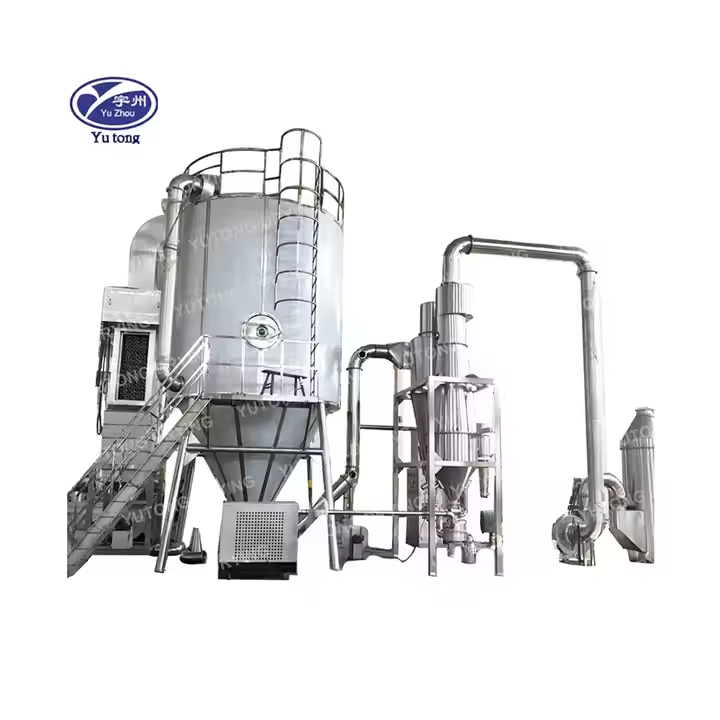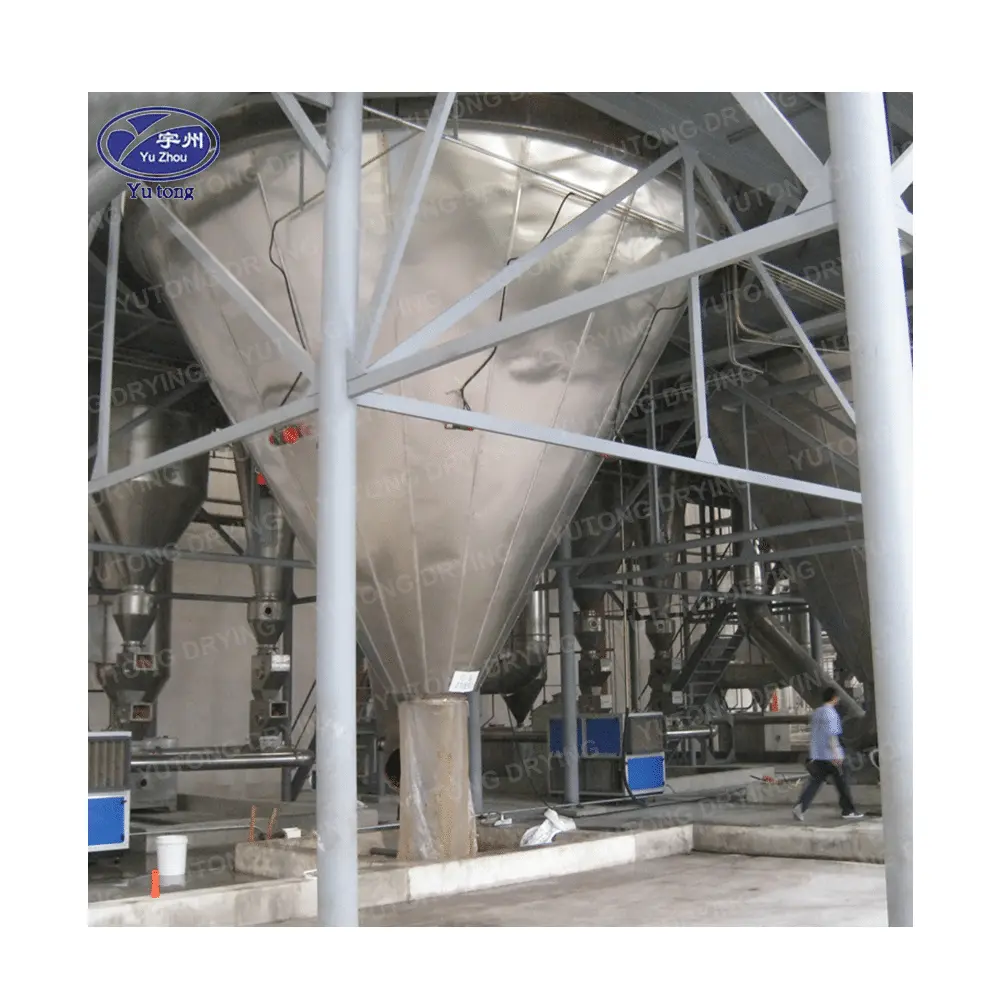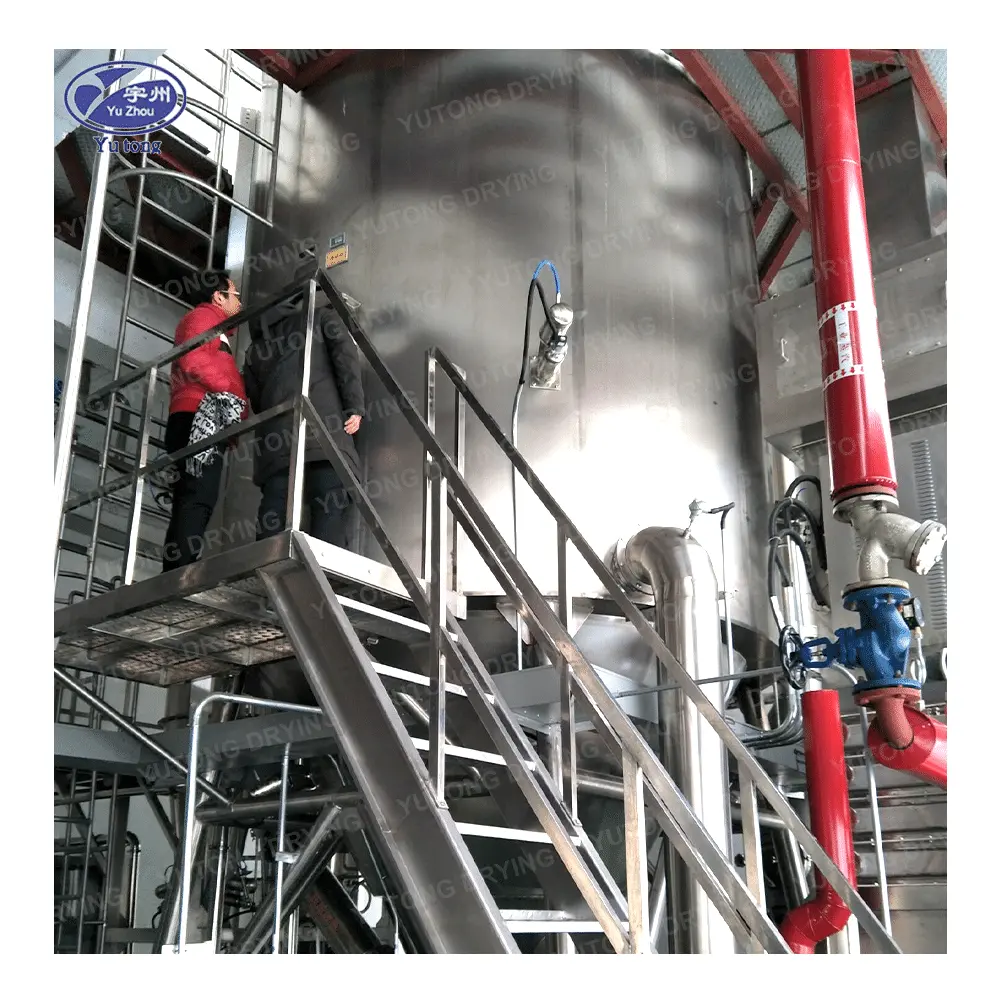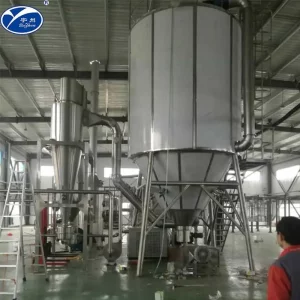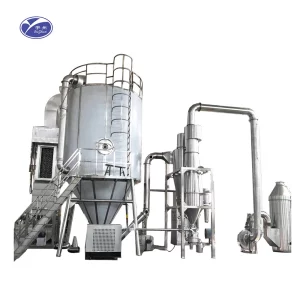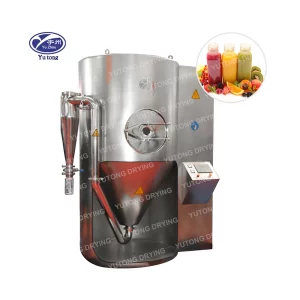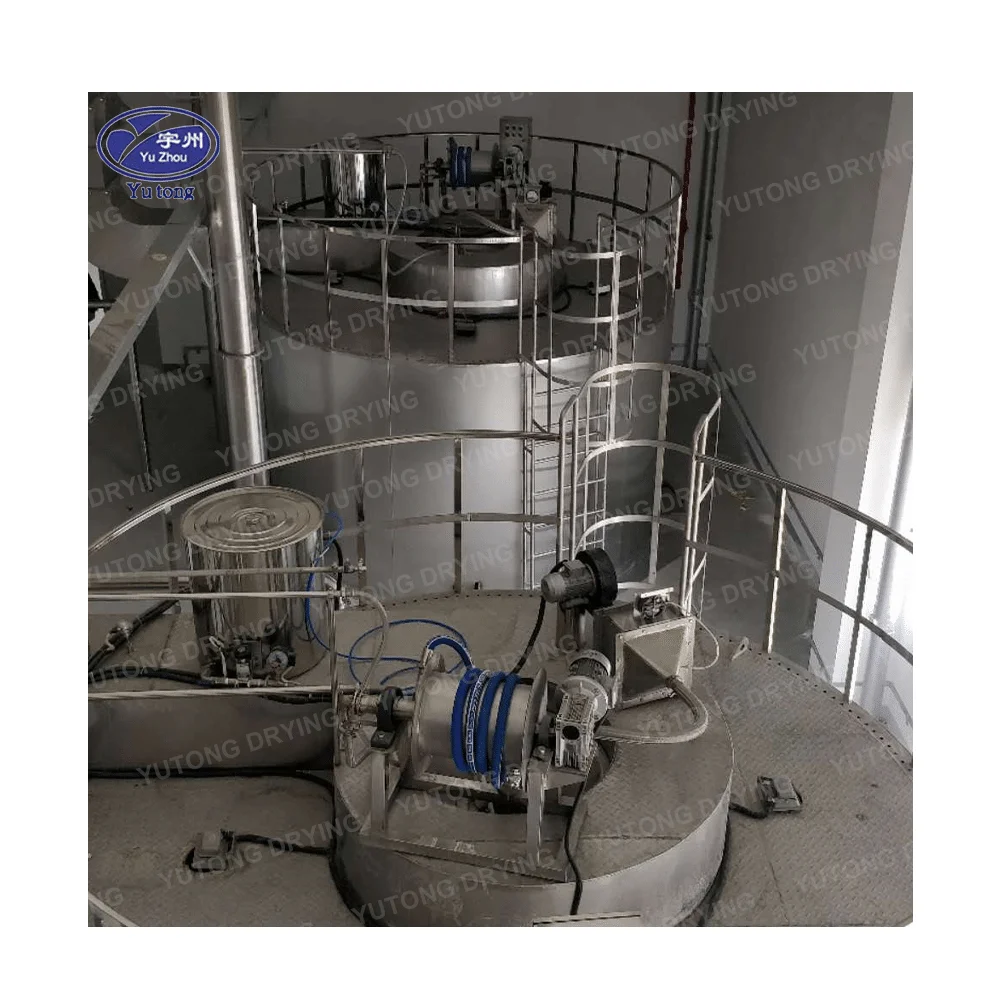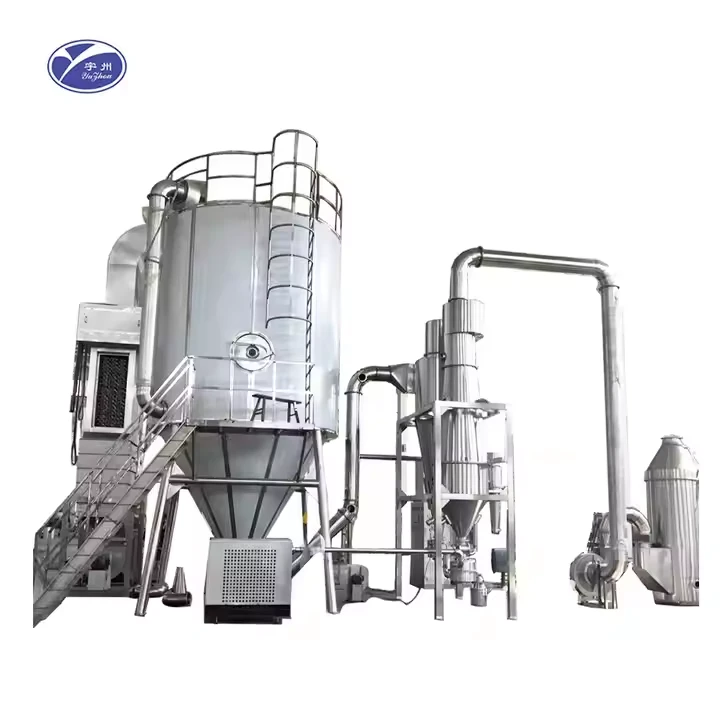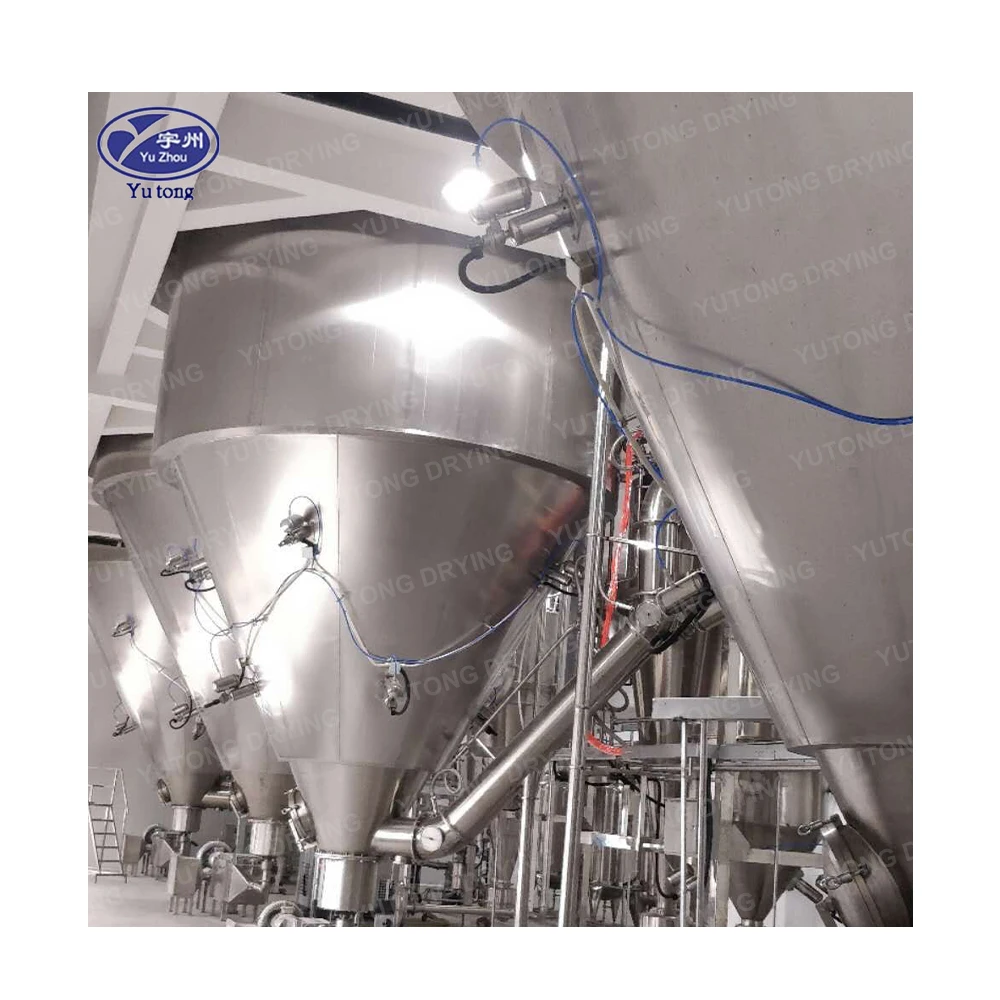
جدول المحتويات
تفاصيل المنتج
chemical spray dryer
In the dynamic realm of material processing and product formulation, spray drying has emerged as a highly efficient and versatile method. This technology has been a game-changer across various industries, from food production to pharmaceuticals, making it integral to the development of fine powders from diverse liquids. This article delves deeper into the complexities of spray dryers, exploring their numerous applications, advantages, and the advanced technology that makes them indispensable.
ما هو مجفف الرش؟
A spray dryer is an innovative machine designed to convert a liquid solution into a dry powder in a single, streamlined step. This remarkable process involves atomizing the liquid into a fine mist, which is then subjected to a hot gas. The hot gas rapidly evaporates the solvent, leaving behind dry particles. The outcome is a fine, uniform powder that serves various applications, ranging from food production to pharmaceuticals.
عملية الذرة
The atomization process is the heart of spray drying. It involves transforming the liquid into a mist of fine droplets. This transformation is crucial because it increases the surface area of the liquid, allowing for rapid solvent evaporation. The method of atomization can vary, and choosing the proper technique is vital for achieving the desired particle size and consistency.
Heat Transfer Mechanics
Heat transfer is another key component of spray drying. The interaction between the hot gas and the atomized droplets determines the rate of solvent evaporation. Understanding the principles of heat transfer helps in optimizing the drying process, ensuring that sensitive materials are not thermally degraded while achieving efficient drying.
Powder Collection Techniques
Once the solvent has evaporated, the resulting dry particles must be collected efficiently. Various powder collection techniques are employed, such as cyclones, bag filters, or electrostatic precipitators. These techniques are designed to maximize the yield of the desired powder while minimizing waste and energy consumption.
أنواع مجففات الرش
Spray dryers come in various designs, each tailored to meet specific processing needs and product requirements. Here, we explore the most prevalent types, each offering unique advantages.
مجفف الرش التقليدي
Conventional spray dryers are the backbone of large-scale industrial operations. They feature a single drying chamber where both atomization and drying co-occur. This design is particularly effective for high-volume production, ensuring consistency and efficiency. The simplicity of conventional dryers makes them a cost-effective choice for many industries.
Multi-Stage Spray Dryer
Multi-stage spray dryers incorporate additional drying stages to enhance energy efficiency and product quality. By using multiple stages, these dryers can achieve lower moisture content and produce powders with better flow properties. This design is particularly beneficial for heat-sensitive products, as it allows for controlled drying at lower temperatures.
Laboratory Spray Dryer
Laboratory spray dryers are essential tools in research and development. These units are designed to handle small batch sizes and offer precise control over drying parameters. This precision makes them ideal for experimenting with new formulations and optimizing processes before scaling up to full production.
Specialized Spray Dryers
In addition to the standard types, there are specialized spray dryers designed for unique applications. These include closed-loop spray dryers for solvent recovery, spray freeze dryers for low-temperature applications, and spray granulators for creating larger, uniform particles.
تطبيقات مجففات الرش
Spray dryers are used in a wide range of industries. Their versatility and efficiency make them indispensable in several sectors.
صناعة الأغذية
In the food industry, spray dryers are pivotal for producing milk powders, coffee creamers, and flavorings. They ensure that the nutritional content and flavor of food products are preserved while extending their shelf life. The ability to produce uniform and stable powders is critical for maintaining product quality and consumer satisfaction.
Pharmaceutical and Chemical Industries
In the pharmaceutical industry, spray dryers create fine powders that enhance the solubility and bioavailability of drugs. This process is crucial for developing effective medications with consistent dosages. In the chemical industry, spray dryers dry and process chemicals like detergents, catalysts, and pigments, ensuring uniformity and quality in the final products.
DDGS Process
Spray dryers play a significant role in the DDGS (Distillers Dried Grains with Solubles) process, which is integral to biofuel production. They facilitate the efficient separation and drying of grains, resulting in a valuable byproduct used as animal feed. This process not only supports sustainable biofuel production but also adds value to agricultural waste.
Emerging Applications
As technology advances, new applications for spray dryers continue to emerge. They are now being used in the production of advanced materials, such as ceramics and nanomaterials, where precise control over particle size and morphology is crucial. This expanding range of applications highlights the growing importance of spray-drying technology in modern manufacturing.
مزايا مجففات الرش
Spray dryers offer many advantages over other drying methods, making them a preferred choice in many industries.
التجفيف السريع
One of the primary benefits of spray drying is its rapid drying capability. The process is swift, significantly reducing the risk of thermal degradation of sensitive materials. This speed is especially beneficial for preserving the active ingredients and flavors in food and pharmaceuticals.
حجم الجسيمات الموحد
Spray drying produces powders with a consistent particle size, which is essential for precise product formulation. Uniformity in particle size ensures better flow properties, dissolution rates, and mixing behavior, all of which are critical for product quality and performance.
قابلية التوسع
Spray dryers are highly scalable, making them suitable for both lab-scale experiments and large-scale industrial production. This scalability allows manufacturers to easily transition from research and development to full-scale production without compromising product quality.
التنوع
Spray dryers’ versatility is unmatched. They can handle a wide range of materials, from heat-sensitive pharmaceuticals to robust chemicals. This flexibility makes them invaluable tools for manufacturers who need to process diverse materials while maintaining high-quality standards.
المكونات الرئيسية لمجفف الرش
Understanding the key components of a spray dryer is essential for optimizing the drying process and achieving the desired product quality.
رذاذ
The atomizer is a crucial component that directly influences the quality of the final product. There are various types of atomizers, each suited to different applications:
- Rotary Atomizer: Utilizes centrifugal force to disperse the liquid into droplets. This type is ideal for achieving uniform droplet size and is commonly used in large-scale operations.
- Nozzle Atomizer: Employs high-pressure nozzles to produce a fine mist. This method is versatile and can be adapted for various applications, including those requiring smaller particle sizes.
غرفة التجفيف
The drying chamber is where the solvent evaporates. It is meticulously designed to allow for optimal airflow and heat distribution, ensuring efficient drying. The size and shape of the chamber can vary, influencing the residence time and, ultimately, the quality of the powder.
Separator
After drying, the separator plays a vital role in collecting the fine particles. It ensures that only dry powder exits the chamber while the evaporated solvent is expelled. Efficient separation is crucial for maximizing yield and maintaining product purity.
Heating System
The heating system provides the necessary energy for evaporation. It must be precisely controlled to maintain the desired temperature throughout the drying process. Advanced heating systems offer improved energy efficiency and temperature control, critical for processing heat-sensitive materials.
الابتكارات في تكنولوجيا مجفف الرش
Recent advancements in spray drying technology have focused on enhancing efficiency and product quality. These innovations are paving the way for more sustainable and effective drying solutions.
Spray Dryer Crystalline Structure
Innovative techniques are being developed to enhance the crystallinity of powders, which is particularly beneficial in pharmaceuticals. Improved crystallinity can enhance the stability and solubility of drugs, leading to better therapeutic outcomes.
Fluidized Spray Dryer Process
The fluidized spray dryer process combines spray drying with fluidization, improving particle agglomeration and drying efficiency. This hybrid approach allows for the production of free-flowing powders with enhanced properties, such as improved solubility and dispersibility.
Spray Dryer Control Systems
Advanced control systems are being integrated into spray dryers, allowing for real-time monitoring and adjustments. These systems optimize the drying process, improving energy efficiency and product quality while reducing operational costs.
Sustainable Innovations
Sustainability is a growing focus in spray dryer technology. Innovations such as closed-loop systems and energy recovery techniques are being developed to reduce the environmental impact of spray drying. These advancements contribute to more eco-friendly manufacturing processes.
Selecting the Right Spray Dryer
Choosing the right spray dryer involves careful consideration of several factors to ensure optimal performance and product quality.
سعة
Matching the spray dryer’s capacity to your production needs is crucial. Whether you require a small, 2-pound-per-hour spray dryer or a large industrial unit, selecting the appropriate capacity ensures efficiency and cost-effectiveness.
توافق المواد
It is vital to ensure that the dryer’s materials are compatible with the substances being processed. This compatibility prevents contamination and ensures the integrity of the final product.
اعتبارات التكلفة
Evaluating the cost of a spray dryer involves more than just the initial investment. Operating costs, maintenance, and potential downtime should all be considered. For instance, lab-scale spray dryer prices in India can vary widely based on features and capacity, so thorough research is necessary to make an informed decision.
Customization and Features
The availability of customization options and additional features can significantly impact a spray dryer’s functionality. Features such as automated controls, advanced monitoring systems, and specialized nozzles can enhance the drying process and product quality.
Leading Spray Dryer Manufacturers
Several manufacturers are renowned for producing high-quality spray dryers, each offering unique advantages.
Dedert Spray Dryer
Dedert Spray Dryer is known for its innovation and efficiency in industrial spray drying. Its products are designed to meet the demands of large-scale operations and offer reliable performance and energy efficiency.
Yamato Laboratory Spray Dryer
Yamato Laboratory Spray Dryer is widespread in research settings for its precision and reliability. These units are ideal for R&D applications, providing researchers with the tools needed to develop and refine new products.
Dye Spray Dryer Manufacturers
Dye Spray Dryer Manufacturers specialize in equipment for the textile and dye industries. Their dryers are designed to handle the unique challenges of dye processing, ensuring consistent and high-quality results.
Emerging Players
New manufacturers are entering the market, offering innovative solutions and competitive pricing. These emerging players are driving advancements in spray drying technology and expanding the range of available options for consumers.
خاتمة
Spray dryers are indispensable in modern industrial processes, offering efficient and versatile solutions for drying a wide range of materials. Whether you’re involved in food processing, pharmaceuticals, or chemical manufacturing, understanding the capabilities and benefits of spray dryers can enhance your production line and product quality. By selecting the right equipment and leveraging the latest innovations, you can optimize your drying processes and achieve superior results.
Remember, when considering a spray dryer for your application, it’s essential to understand your specific needs and consult with experts or manufacturers to find the best fit for your operations. With the right choice, a spray dryer can be a valuable addition to your production capabilities, driving efficiency and product excellence across industries.
تحديد
|
المواصفات
|
زد بي جي-25
|
زد بي جي-50
|
زد بي جي-80
|
زد بي جي-100
|
زد بي جي-150
|
زد بي جي-200
|
زد بي جي-300
|
|
|
قدرة التبخر (كجم/ساعة)
|
25
|
50
|
80
|
100
|
150
|
200
|
300
|
|
|
كمية المادة السائلة في العملية (كجم/ساعة)
|
25-34
|
50-68
|
80-108
|
100-135
|
150-203
|
200-270
|
300-406
|
|
|
إنتاج المنتج النهائي (كجم/ساعة)
|
4.8-7.2
|
9.2-14
|
14.8-22.4
|
18.4-28
|
24-42
|
36.8-56.4
|
55-85
|
|
|
محتوى المواد الصلبة من المواد السائلة (%)
|
18-30
|
|||||||
|
نسبة الرطوبة في المنتج النهائي (%)
|
3-5
|
|||||||
|
الطاقة الكهربائية (كيلوواط)
|
63
|
132
|
153
|
204
|
246
|
330
|
||
|
مصدر الحرارة
|
بخار بيوس الكهرباء
|
|||||||
|
طريقة جمع المنتج وكفاءته
|
مزيل الغبار الرطب من الدرجة الأولى أو الثانية أو الثالثة أكبر من أو يساوي 95%
|
|||||||
|
عدادات وأجهزة التحكم التلقائي
|
مؤشر عدم وجود هواء ودرجة حرارة الهواء العادم
|
|||||||
|
درجة حرارة مدخل الهواء (℃)
|
160-220
|
|||||||
|
درجة حرارة مخرج الهواء (℃)
|
80-100
|
|||||||
|
ل
|
7000
|
8000
|
9800
|
11000
|
12200
|
14100
|
15000
|
|
|
الأبعاد الكلية (مم)
|
و
|
4000
|
5000
|
5700
|
6200
|
7000
|
7800
|
9000
|
|
ح
|
6200
|
6900
|
8000
|
8900
|
10750
|
11900
|
13000
|
|
التطبيقات
لم يتم العثور على أي محتوى يتطابق مع اختيارك.

